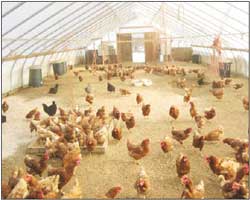



Lighting for Alternative Poultry Production
Energy-Efficient Lighting for the Farm from the US National Sustainable Agriculture Information Service (ATTRA) provides an overview of energy-efficient lighting technology and explains how to select lighting options that are appropriate for the farm, including alternative poultry production.Energy-efficient lighting options present farmers with new opportunities to reduce electricity costs and help manage farms sustainably. Cost-effective energy-efficient lighting can be used to improve productivity and safety, and reduce operating costs.
Supplemental lighting is normally used by alternative egg producers to maintain productivity, and sometimes for alternative broiler production in northern climates. Small layer flocks housed during late spring through mid-summer with daily access to the outdoors do not require supplemental light. Supplemental lighting is necessary for pullets to maintain production during late fall and winter as days shorten.

Photo courtesy of Jericho Settlers' Farm
Poultry are very sensitive to three aspects of light: intensity of light (measured in footcandles), wavelength (measured in color temperature), and day length (duration of light period). Research by Michael Darre and others has found that blue light wavelengths help calm birds; red wavelengths may be used to help reduce feather picking; blue-green wavelengths help maintain growth; and orange-red wavelength helps maintain reproduction.
The light intensity for layers should be enough to read a newspaper by and will vary with the poultry breed. Generally, 'warm' wavelength lamps of less than 3,000K in the red-orange spectrum are best for small flocks with outdoor access. The day length should never be extended past 16 hours or the longest day of the year.
Solar photovoltaic lighting provides a simple solution to maintaining egg production during shorter days. Solar lighting systems basically consist of a solar module, a deep-cycle battery, a charge controller, a 12V programmable timer, and an efficient DC lighting fixture with lamp. Energy-efficient LED lamps work very well with solar modules. All of the components to build a basic low-voltage solar lighting system can be purchased online for less than $300 or as a kit.

To conserve energy and keep poultry healthy, use timers to switch lights on and off. Programmable timers must be 12V when used in conjunction with a 12V solar lighting system. Th ere are 12V timers available online as well as schematics to convert a household programmable thermostat to a 12V timer. Timers also ensure that birds receive a uniform number of light hours each day. Set timers to light in the morning instead of the evening to give birds a natural dusk and allow them to roost. Check timers at least once a week, and clean lamps if dust builds up. Lamps should be free of obstructions that cause shadows on the floor.
Baby chicks require additional light in their first 72 hours to help them find food and water. A low watt 'warm' lamp is recommended for every 200 square feet of floor space. (Hawes) The high heat from incandescent lamps may double as a brood light and heat source, although it may be more energy-efficient (and cost-effective) to use a separate heat source and a solar lighting system.
More information on poultry lighting is available in the ATTRA publication Poultry House Management for Alternative Production.
Further Reading
| - | You can view the full report Energy-Efficient Lighting for the Farm by clicking here. |
Further Reading
| - | You can view the ATTRA publication Poultry House Management for Alternative Production by clicking here. |
December 2010









